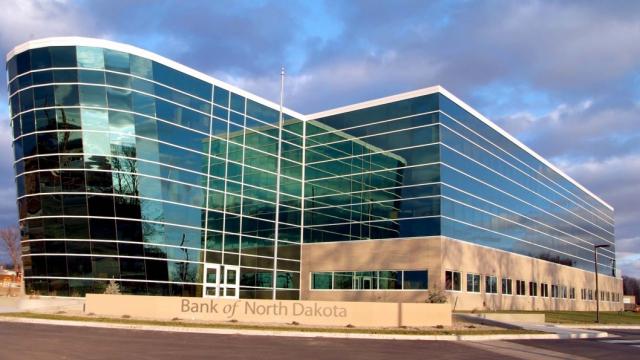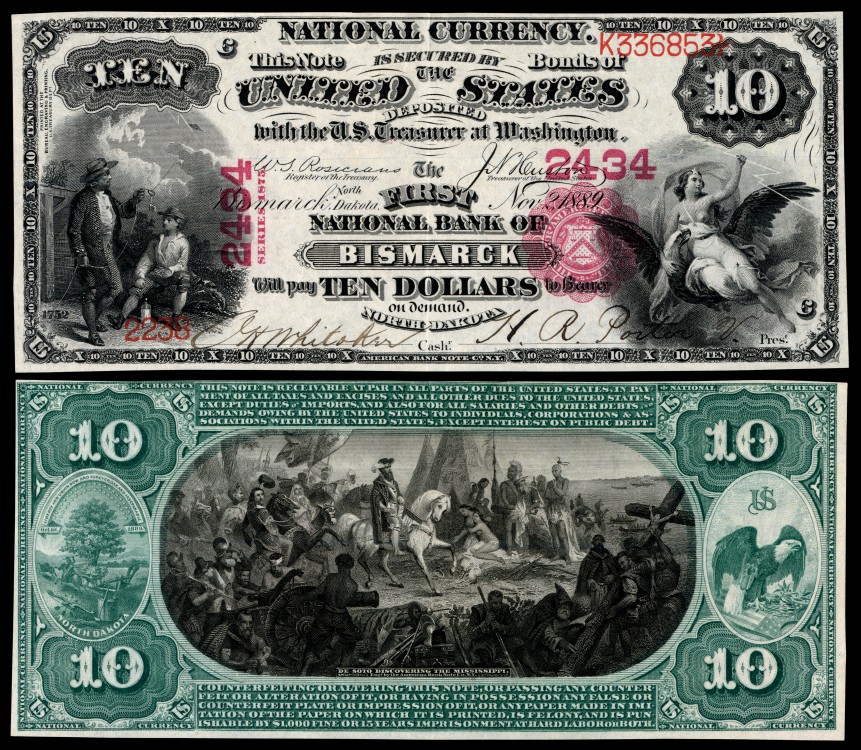
In November 2014, the Wall Street Journal reported that the Bank of North Dakota (BND), the nation’s only state-owned depository bank, was more profitable even than J.P. Morgan Chase and Goldman Sachs. The author attributed this remarkable performance to the state’s oil boom; but the boom has now become an oil bust, yet the BND’s profits continue to climb. Its 2015 Annual Report, published on April 20, boasted its most profitable year ever.
The BND has had record profits for the last 12 years, each year outperforming the last. In 2015 it reported $130.7 million in earnings, total assets of $7.4 billion, capital of $749 million, and a return on investment of a whopping 18.1 percent. Its lending portfolio grew by $486 million, a 12.7 percent increase, with growth in all four of its areas of concentration: agriculture, business, residential, and student loans.
By increasing its lending into a collapsing economy, the BND has helped prop the economy up. In 2015, it introduced new infrastructure programs to improve access to medical facilities, remodel or construct new schools, and build new road and water infrastructure. The Farm Financial Stability Loan was introduced to assist farmers affected by low commodity prices or below-average crop production. The BND also helped fund 300 new businesses.
Those numbers are particularly impressive considering that North Dakota has a population of only about 750,000, just half the size of Phoenix or Philadelphia. Compare that to California, the largest state by population, which has more than fifty times as many people as North Dakota.
What could California do with its own bank, following North Dakota’s lead? Here are some possibilities, including costs, risks and potential profits.
Getting Started: Forming a Bank Without Cost to the Taxpayers
A bank can be started in California with an initial capitalization of about $20 million. But let’s say the state wants to do something substantial and begins with a capitalization of $1 billion.
Where to get this money? One option would be the state’s own pension funds, which are always seeking good investments. Today state pension funds are looking for a return of about 7% per year (although in practice they are getting less). One billion dollars could be raised more cheaply with a bond issue, but tapping into the state’s own funds would avoid increasing state debt levels.
At a 10% capital requirement, $1 billion in capitalization is sufficient to back $10 billion in new loans, assuming the bank has an equivalent sum in deposits to provide liquidity.
Where to get the deposits? One possibility would be the California Pooled Money Investment Account (PMIA), which contained $67.7 billion earning a modest 0.47% as of the quarter ending March 31, 2016. This huge pool of rainy day, slush and investment funds is invested 47.01% in US Treasuries, 16.33% in certificates of deposit and bank notes, 8.35% in time deposits, and 8.91% in loans, along with some other smaller investments. A portion of this money could be transferred to the state-owned bank as its deposit base, on which 0.5% could be paid in interest, generating the same average return that the PMIA is getting now.
For our hypothetical purposes, let’s say $11.1 billion is transferred from the PMIA and deposited in the state-owned bank. With a 10% reserve requirement, $1.1 billion would need to be held as reserves. The other $10 billion could be lent or invested. What could be done with this $10 billion? Here are some possibilities.
Slashing the Cost of Infrastructure
One option would be to fund critical infrastructure needs. Today California and other states deposit their revenues in Wall Street banks at minimal interest, then finance infrastructure construction and repair by borrowing from the Wall Street bond market at much higher interest. A general rule for government bonds is that they double the cost of projects, once interest is paid. California and other states could save these costs simply by being their own bankers and borrowing from themselves; and with their own chartered banks, they could do it while getting the same safeguards they are getting today with their Wall Street deposits and investments. The money might actually be safer in their own banks, which would not be subject to the bail-in provisions now imposed by the G-20’s Financial Stability Board on giant “systemically risky” banking institutions.
To envision the possibilities, let’s say California decided to fund its new bullet train through its state-owned bank. In 2008, Californians approved a bond issue of $10 billion as the initial outlay for this train, which was to run from Los Angeles to San Francisco. At then-existing interest rates, estimates were that by the time the bonds were paid off, California taxpayers would have paid an additional $9.5 billion in interest.
So let’s assume the $10 billion in available assets from the state-owned bank were used to repurchase these bonds. The state would have saved $9.5 billion, less the cost of funds.
It is not clear from the above-cited source what the length of the bond issue was, but assume it was for 20 years, making the interest rate about 3.5%. The cost of one billion dollars in capital for 20 years at 7% would be $2.87 billion, and the cost of $11.1 billion in deposits at 0.5% would be $1.164 billion. So the total cost of funds would be $4.034 billion. Deducted from $9.5 billion, that leaves about $5.5 billion in savings or profit over 20 years. That’s $5.5 billion generated with money the state already has sitting idle, requiring no additional borrowing or taxpayer funds.
What about risk? What if one of the cities or state agencies whose money is held in the investment pool wants to pull that money out? Since it is held in the bank as deposits, it would be immediately liquid and available, as all deposits are. And if the bank then lacked sufficient liquidity to back its assets (in this case the repurchase of its own bonds), it could in the short term do as all banks do – borrow from other banks at the Fed funds rate of about 0.35%, or from the Federal Reserve Discount Window at about 0.75%. Better yet, it could simply liquidate some of the $56 billion remaining in the PMIA and deposit that money into its state bank, where the funds would continue to earn 0.5% interest as they are doing now.
Assume that from its $5.5 billion in profits, the bank then repaid the pension funds their $1 billion initial capital investment. That would leave $4.5 billion in profit, free and clear – a tidy sum potentially generated by one man sitting in an office shuffling computer entries, without new buildings, tellers, loan officers or other overhead. That capital base would be sufficient to capitalize about $40 billion in new loans, all generated without cost to the taxpayers.
A California New Deal
The bullet train example is a simple way to illustrate the potential of a state-owned bank, but there are many other possibilities for using its available assets. As the BND did after building up its capital base, the bank could advance loans at reasonable rates for local businesses, homeowners, students, school districts, and municipalities seeking funds for infrastructure.
These loans would be somewhat riskier than buying back the state’s own bonds, and they would involve variable time frames. Like all banks, the state bank could run into liquidity problems from borrowing short to lend long, should the depositors unexpectedly come for their money. But again, that problem could be fixed simply by liquidating some portion of the money remaining in the PMIA and depositing it in the state-owned bank, where it would earn the same 0.5% interest it is earning now.
Here is another intriguing possibility for avoiding liquidity problems. The bank could serve simply as intermediator, generating loans which would then be sold to investors. That is what banks do today when they securitize mortgages and sell them off. Risk of loss is imposed on the investors, who also get the payment stream; but the bank profits as well, by receiving fees for its intermediating functions.
The federally-owned Reconstruction Finance Corporation (RFC) did something similar when it funded a major portion of the New Deal and World War II by selling bonds. This money was then used for loans to build infrastructure of every sort and to finance the war. According to a US Treasury report titled Final Report of the Reconstruction Finance Corporation (Government Printing Office, 1959), the RFC loaned or invested more than $40 billion from 1932 to 1957 (the years of its operation). By some estimates, the sum was about $50 billion. A small part of this came from its initial capitalization. The rest was borrowed – $51.3 billion from the US Treasury and $3.1 billion from the public. The RFC financed roads, bridges, dams, post offices, universities, electrical power, mortgages, farms, and much more, while at the same time making money for the government. On its normal lending functions (omitting such things as extraordinary grants for wartime), it wound up earning a total net income of $690 million.
North Dakota has led the way in demonstrating how a state can jump-start a flagging economy by keeping its revenues in its own state-owned bank, using them to generate credit for the state and its citizens, bypassing the tourniquet on the free flow of credit imposed by private out-of-state banks. California and other states could do the same. They could create jobs, restore home ownership, rebuild infrastructure and generally stimulate their economies, while generating hefty dividends for the state, without increasing debt levels or risking public funds – and without costing taxpayers a dime.
3 WAYS TO SHOW YOUR SUPPORT
- Log in to post comments














